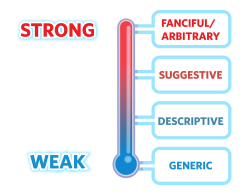It’s important to have a strong trademark that is inherently distinctive. This means your trademark quickly and clearly identifies you as the source of your goods or services. The stronger your trademark is, the more easily you can prevent others from using it without your permission. Weak trademarks can be difficult and costly for you to defend because they don’t have the same legal protections as stronger trademarks.
Strong trademarks are suggestive, fanciful, or arbitrary. Weak trademarks are descriptive or generic. Think about them this way. You want your trademark to be strong or “hot,” as opposed to weak or “cold.”
Acceptable trademarks
Strong trademarks are typically creative or unique, setting you apart from your competitors. These trademarks include fanciful, arbitrary, or suggestive trademarks.
Fanciful trademarks are invented words. They only have meaning in relation to their goods or services. For example, Exxon® for petroleum or Pepsi® for soft drinks.
Arbitrary trademarks are actual words that have no association with the underlying goods or services. Think of the term “apple.” If an apple orchard tried to register the word “apple” as a trademark for the type of apples they grow, that trademark wouldn’t be registerable. But, Apple® has been registered as a trademark for computers. Apple® for computers is unique.
Suggestive trademarks are words that suggest some quality of the goods or services, but don’t state that quality of the goods or services outright. Consider Coppertone® for sun-tanning products. The trademark gives the impression that using Coppertone® suntan oil will make your skin shimmer like copper.
Unacceptable trademarks
Weak trademarks are hard to protect against competitors and often are not federally registrable. These include descriptive and generic trademarks.
Descriptive trademarks merely describe some aspect of your goods or services without identifying or distinguishing the source of those goods or services. They’re only registrable in certain circumstances, such as your trademark gaining distinctiveness through extensive use in commerce over many years.
Some examples of descriptive trademarks are:
- “Creamy” for yogurt
- “Apple pie” for potpourri
- “Bed & breakfast registry” for lodging reservations services
You may wonder how descriptive and suggestive trademarks differ. Descriptive trademarks immediately give an idea of what the goods or services are, while suggestive trademarks allude to the goods or services. For example, the word “bronzer” for suntan oil would be descriptive of an oil that helps bronze the skin and wouldn’t be registered alone as a trademark for those goods, while Coppertone® is a suggestive, registered trademark for sun-tanning products.
Generic trademarks aren’t even trademarks. They’re merely the common, everyday name for your goods or services. As such, they do not indicate source and cannot function as trademarks. Therefore, generic trademarks are not federally registrable.
Some examples are:
- “Bicycle” for bicycles
- “Bagel shop” for a bagel shop
- “E-ticket” for computerized reservation and ticketing of transportation services
Other factors to consider
You should consider whether the public will remember, pronounce, and spell your trademark.
If you plan to market your goods or services outside the United States under the same trademark, consider whether your trademark has a different meaning when translated into a foreign language, particularly if the translated word could be considered offensive.


